DIY Faux Metal Embellishments for Crafts
Hello there! It’s Heather, from Thicketworks. I’d like to share a marvelous Mixed Media Art technique with you for creating DIY Faux Metal Embellishments for Crafts… and we are going to be starting with ordinary Cardstock! With this method, you can add another dimension to the images that Karen provides for us here.
I love the look and feel of antique and patina-encrusted surfaces. I also love classic scrollwork and fancy vintage designs, but can’t afford to pick up antique pieces to play with. To satisfy my lust for (faux) ancient embellishments for my projects, I make my own, with a little help from TGF and the hardware store.
So, here’s my process – the basis of which I learned from the talented David Neat, in his wonderful book Model-Making: Materials and Methods. Mr. Neat might be a little queasy when (if) he sees the sloppy way I’ve abused his meticulous methods, but hey.
Be prepared to devote several hours to this, due to drying times. Have fun!
For this project, I started with these gorgeous images from The Graphics Fairy: Fancy Scroll and Frame. I printed them on heavyweight cardstock, using a laser printer. (Ink-jet prints will run when we apply wet media and aren’t suitable for this project).
‘Cause we are gonna make a fine mess. Yup. Grab your old shirt, or be prepared with a good story to explain the stains.
Supplies for DIY Faux Metal Embellishments for Crafts
To complete this project you’ll need the following:
- Heavyweight Cardstock
- Access to a laser printer, or have the images printed onto the cardstock by your local copy shop
- Scissors and a craft knife (sharp!)
- Magnifying glasses (if you’re blind like me)
- A Glue Stick
- An emery board or fine gauge files
- A work surface you don’t mind getting messy
- Joint Compound (from the hardware store)
- Water
- A small container to mix your goop in
- A palette knife, to transfer your goop into the little bottle with
- A fine-tipped bottle, or fancy cake decorating tips/bag that you can never use for food again. Darice makes cheap plastic fine-tipped bottles.
- An orange stick, or similar little tool to scrape mistakes off with, unless you’re perfect, (which of course you are).
- A heat tool is optional but will speed drying times
- Gesso or DIY chalk paint
- Modern Masters Reactive Metallic Copper Paint, Green Patina, and Blue Patina
- or craft paints in suitable colors to simulate verdigris
- Modern Masters Reactive Metallic Iron Paint and Rust Activator
- or craft paints in suitable colors to simulate rust
- Inka Gold metallic rubs in Copper and Silver
- Distress Stains of your choosing (water them down for best results)
- Distress Inks of your choosing
- Patience
Tutorial
1) Once the images are printed, cut them out roughly, and glue them to another sheet of heavyweight cardstock, using a glue stick. This double thickness of cardstock serves as the base for the embellishments.
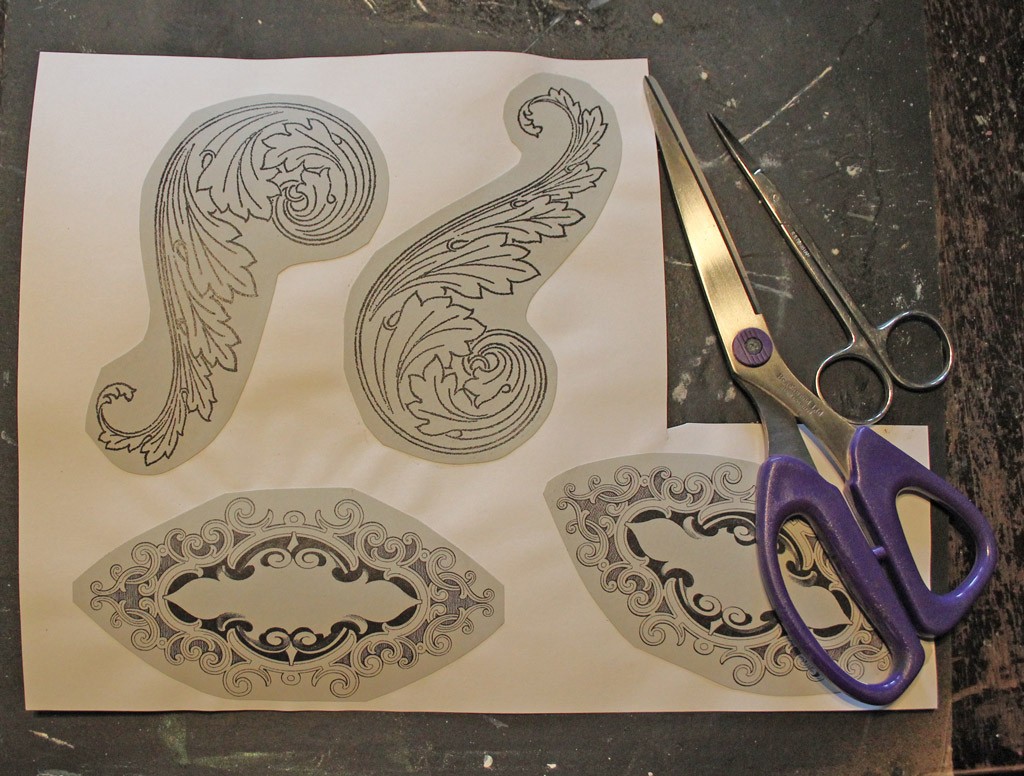
2) Once the glue has dried completely, carefully fussy cut the images out, using a variety of scissors and a craft knife. Waiting for the glue to dry is boring, so go play with the dog or something for a while. You’ll be glad you waited when you begin cutting.
3) Once all of the images are fussy cut, neaten the edges using fine files (an emery board cut into little pieces would work for this).
4) At this point, it’s time to mix a small amount of joint compound with just enough water to make it the consistency of yogurt. Then the concoction is loaded into a fine-tip bottle, (I got mine via Amazon). Or, if you prefer, contaminate your fancy cake-decorating equipment in a way that will make it unsuitable for food, ever again.
Don’t be afraid to experiment with the goop-to-water ratio – a thin slurry will give you more flowing lines, and a drier mix will be less smooth, but gives greater definition. If you have some fancy artistic texture paste lying around, I’m sure it will work just as well.
Just remember to clean out the bottle tip when you’re finished, or it will clog and make you sad. The mix can last for a few days if kept air-tight.
5) Because this project can get really messy, (don’t drip this stuff on your nice carpet) it’s important to create some kind of doohickey to allow you to hold the image cut-outs without touching their sides or tops. To that end, I folded up little scraps of cardstock into triangular tubes and taped them to the undersides of each piece. (I’m sure you can come up with a better solution).
I also recommend working on a surface you don’t mind getting goopy. I use sheets of cardboard.
Now, those of you who have experience decorating cakes will ace this next part. I, however, have never (successfully) managed to decorate any baked goods, and my results just go to show that real skill is not necessary. Really.
6) Using a steady hand, and a good grip on the bottle, pipe along the printed design. I like to start by piping little balls onto the ends of the scroll parts. It’s not important to be perfectly accurate, just select the features you want to emphasize and go for it. I find this process oddly meditative, despite hand cramps.
If you make any mistakes that you can’t live with, just use a small-scale tool to wipe the joint compound off of the surface, and do it again. I use these ridiculously expensive, but oh-so-precise tools, called Royal Sovereign Clay Shapers. I think an orange stick would work just as well, but what the heck, I have the tools, so better use them, right?
7) Once you have added dimension to your cardstock cut-outs, it’s time to wait for them to dry. Again. I use a heat tool to speed things up, but it’s still tedious.
8) When the joint compound/texture paste is completely dry, coat the little guys with a couple of coats of gesso, or DIY chalk paint.
9) And, yep, you guessed it. Wait for them to dry. Or, grab your heat gun and have fun creating an even more uneven surface as the gesso bubbles up.
During all of these processes, the cardstock will tend to warp when damp, then flatten out again as it dries. Try not to be alarmed. It should be okay.
(The joint compound I use is fairly flexible, so it doesn’t flake off during all this bending business).
You could absolutely leave these as is, for a shabby chic vibe. Could be perfect for weddings…
Or, if you’re like me, you’ll be eager to create some grunge. There are many different ways to create patinas. Now, craft paints can be used for this, so use what you have on hand. I used Modern Masters Reactive Metallic Copper Paint, Green Patina, and Blue Patina to get this particular effect.
10) First, a base coat of the Copper Paint. When dry, apply a second coat. While the second coat is still wet, dribble Green Patina over the surface.
12) It looks pretty gross at this point, but I promise, the magic is working! Add some Blue Patina while things are still damp and goopy:
12) Wait for it to dry. I know. Boring. BUT…
The result is so worth it:
14) And, just because I can’t leave well enough alone, a touch of Inka Gold, in Copper on the high points, and we are done.
For variations on this theme, here is an example of Modern Masters Reactive Metallic Iron Paint – again, for a certain look, this would be perfect as is.
Think Victorian Mourning Accessories…
With the addition of Rust Activator, you get ancient deliciousness:
For this example, I experimented with not fussy cutting – just approximating the undulating profile of the graphic with a cheap pair of scissors, then layering Distress Stains over two coats of DIY chalk paint. A final touch of Inka Gold in Silver, and this look is cool, too:
Finally, one last example of how you can use joint compound to lightly emboss a graphic in your Art Journal, or on any type of paper crafting.
I love how the joint compound takes on the tint of Distress Ink when layered over an inked area:
Thanks for joining me for this project – I hope you have as much fun with this simple (if tedious) DIY Faux Metal Embellishments for Crafts technique as I do!
If you like this kind of project, stop by Thicketworks to say hello, and look around.
Take Care!
Heather
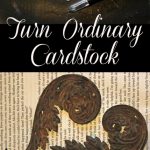
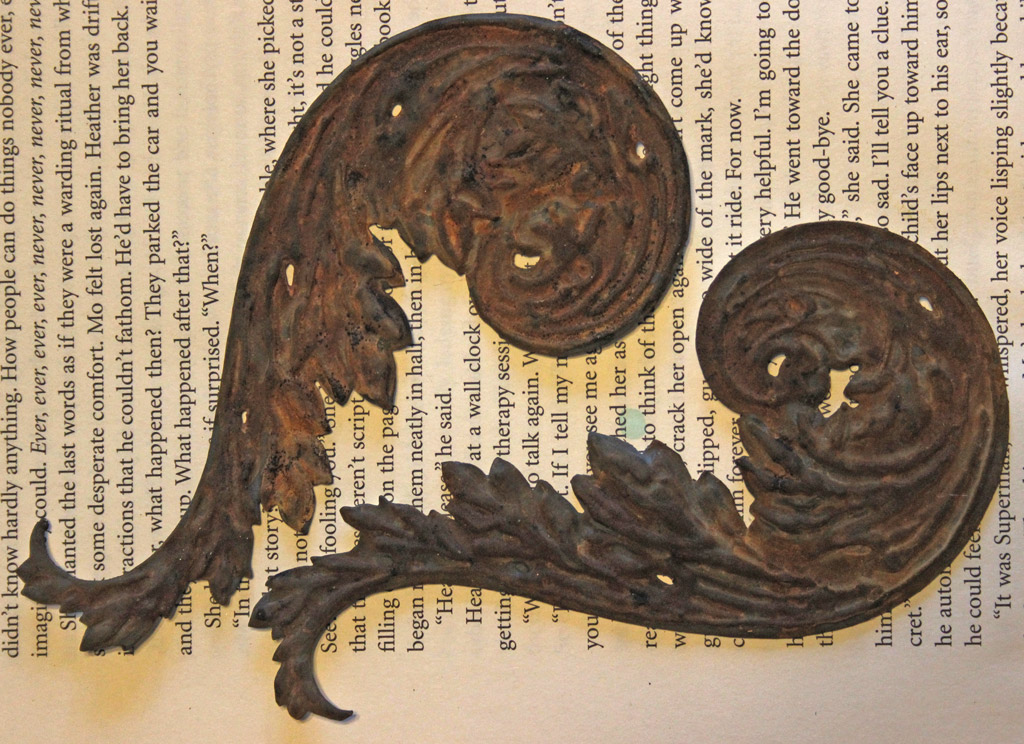
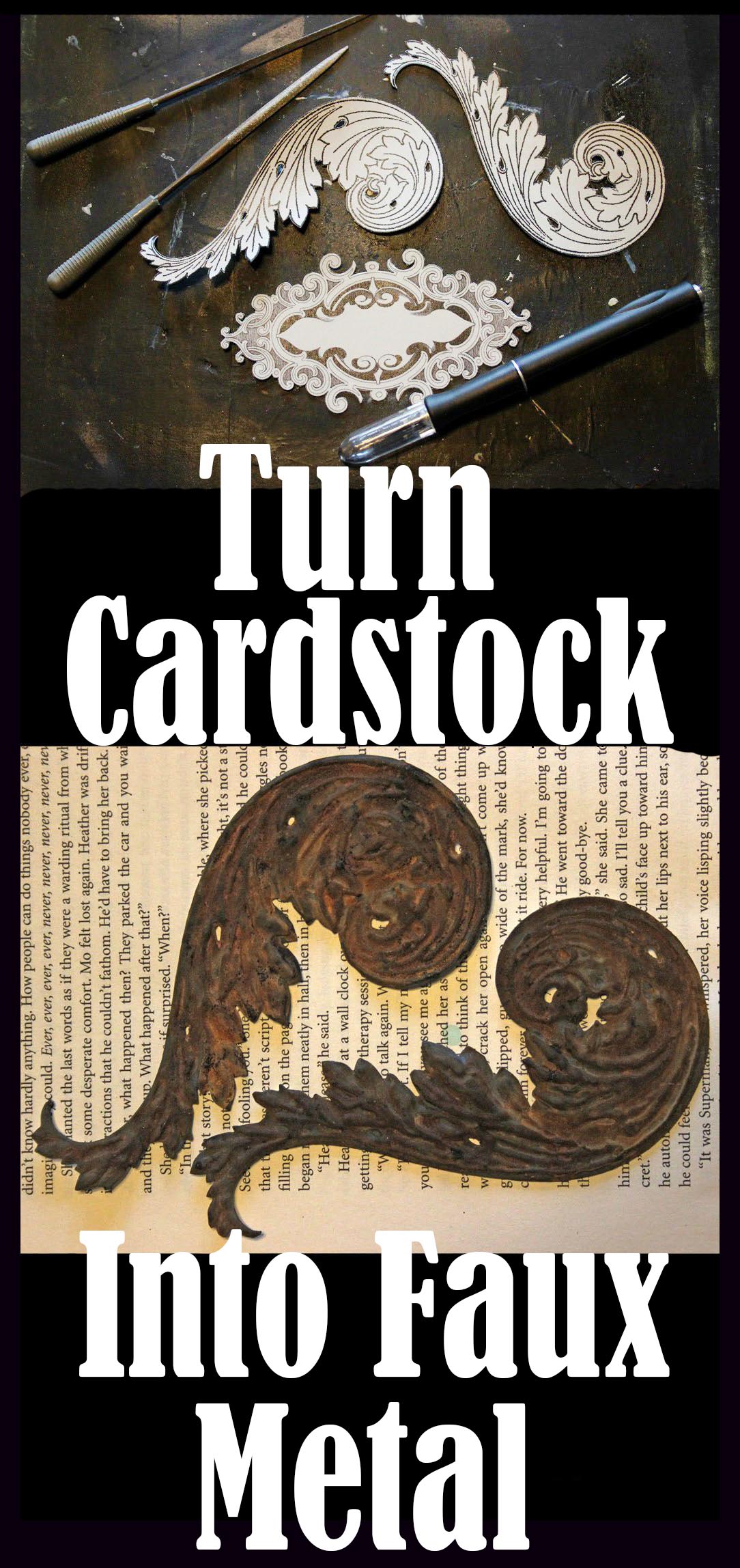
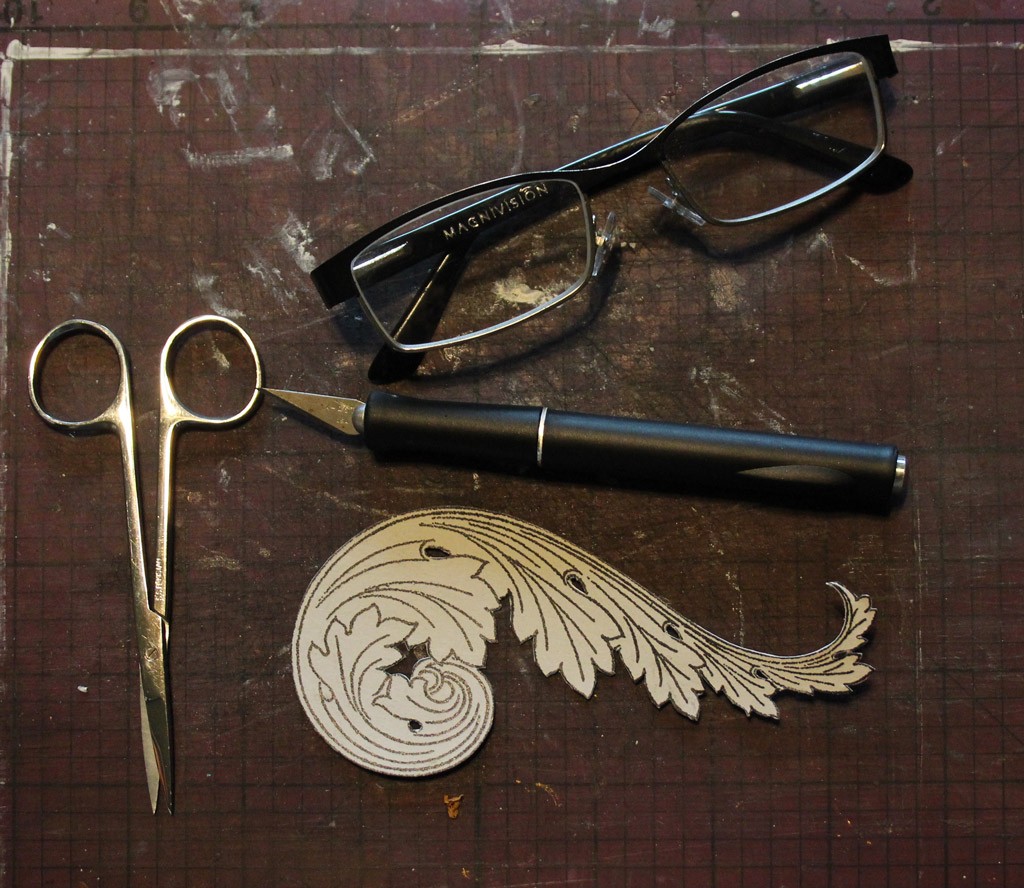
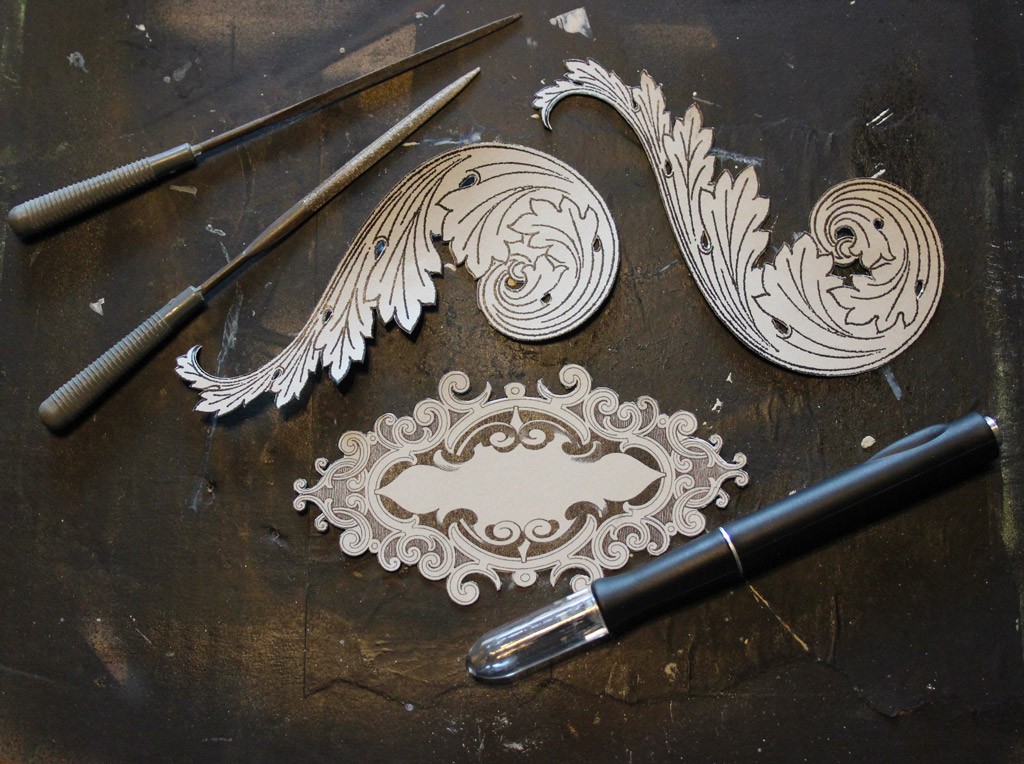
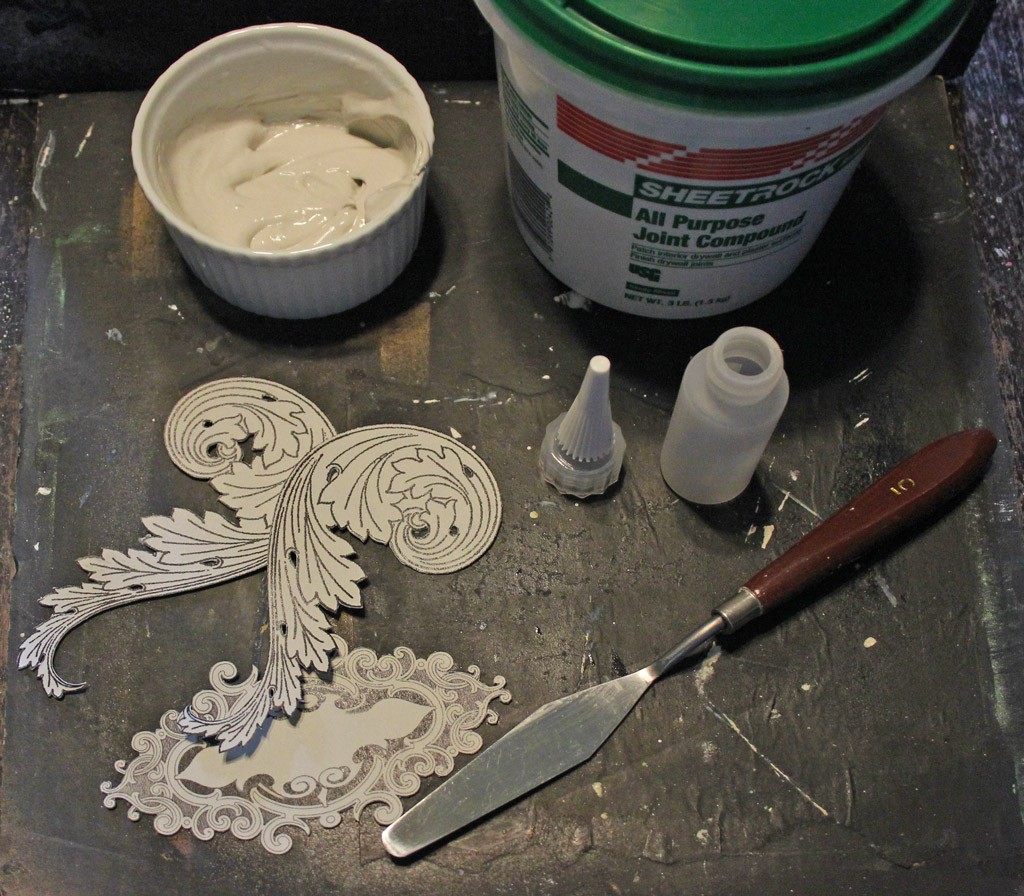
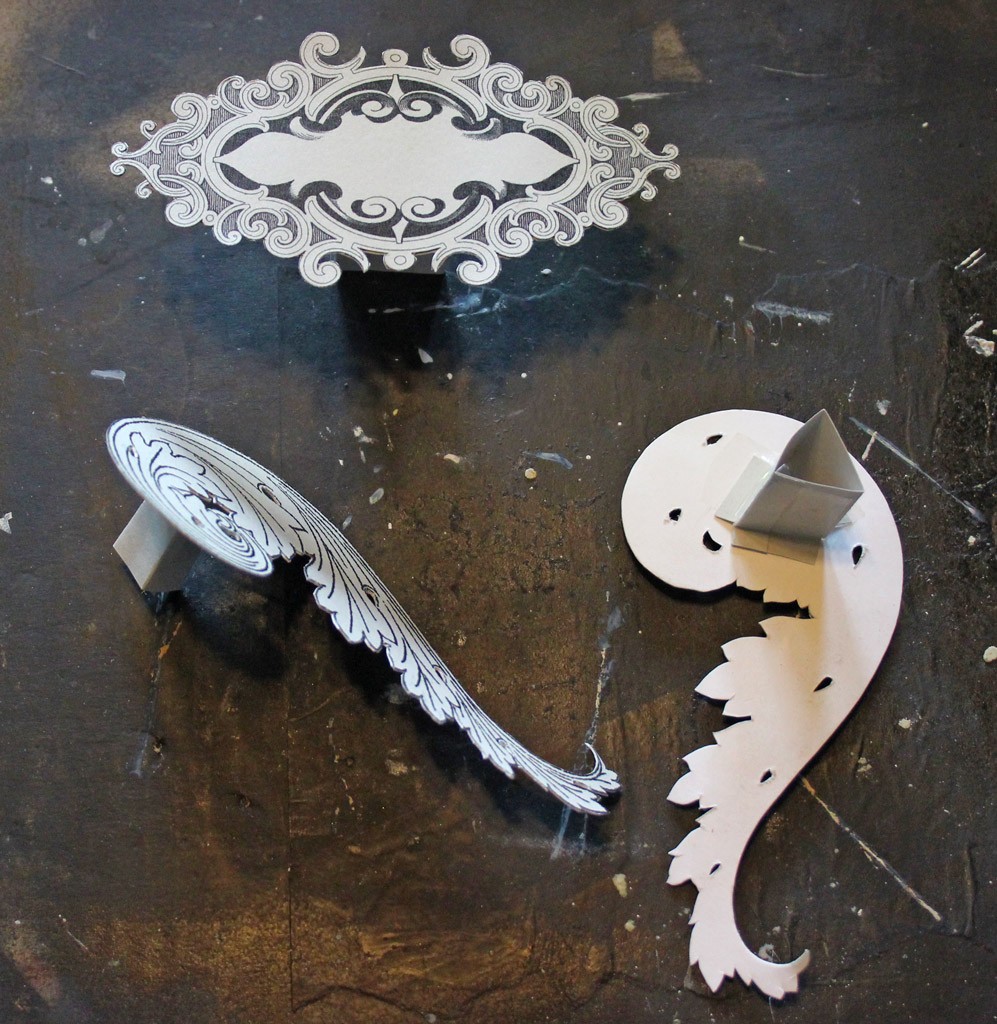
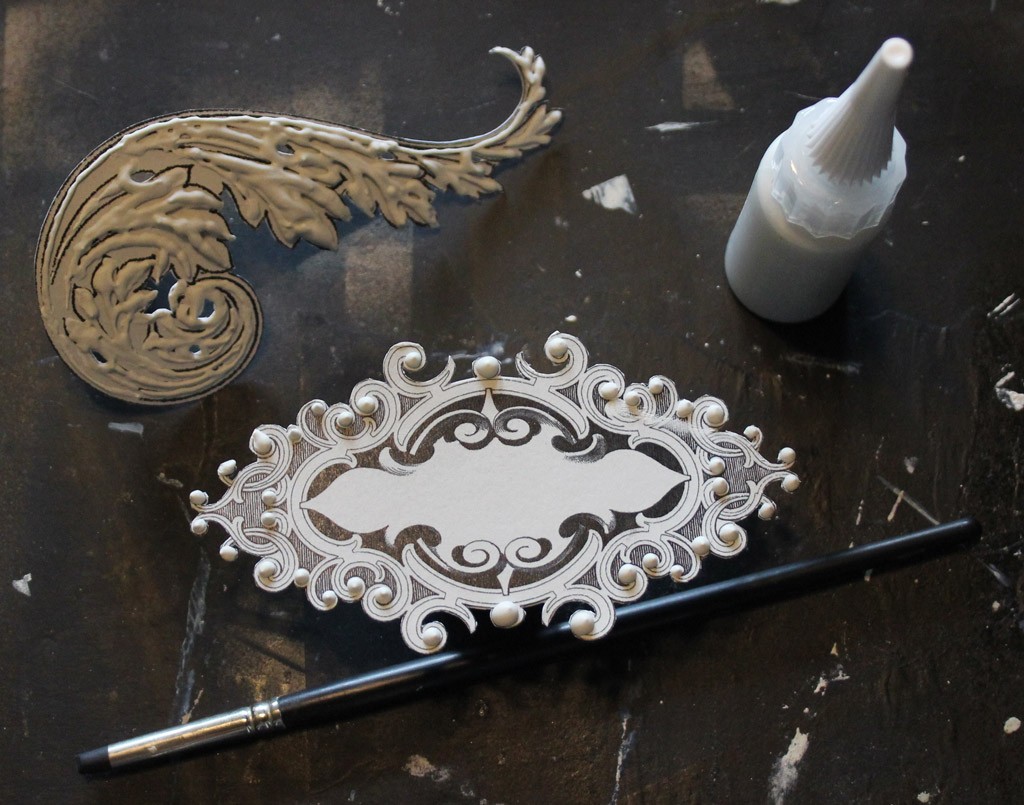
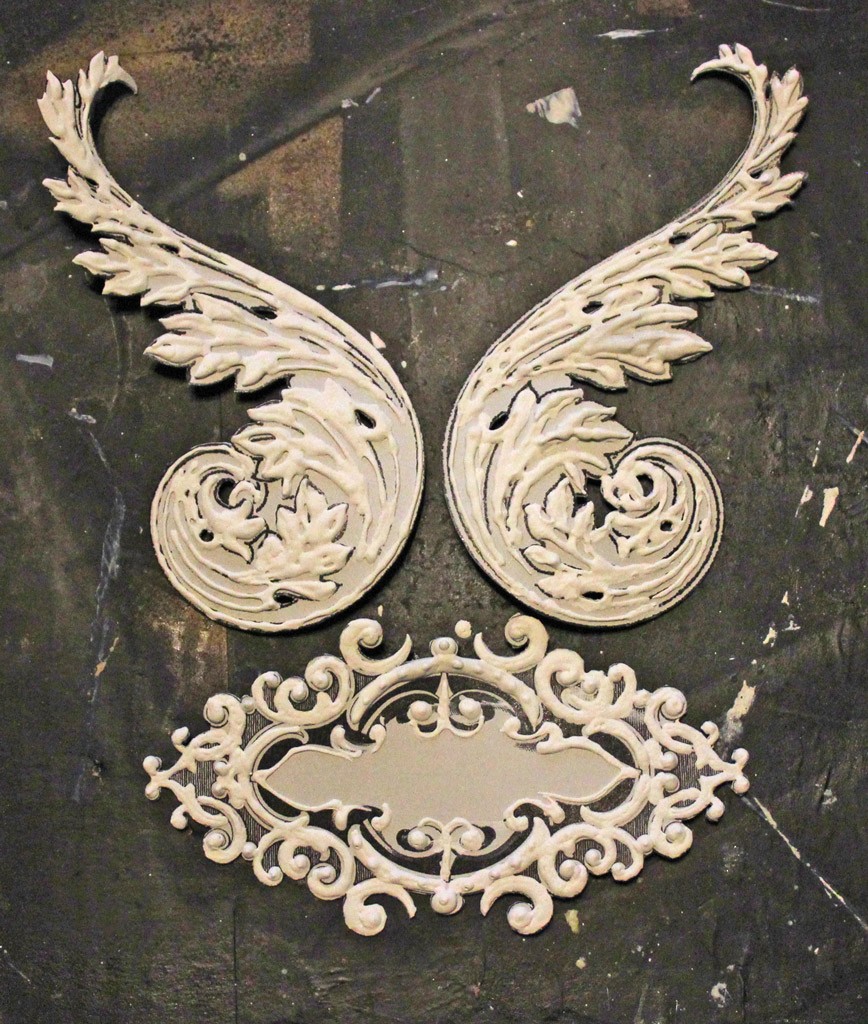
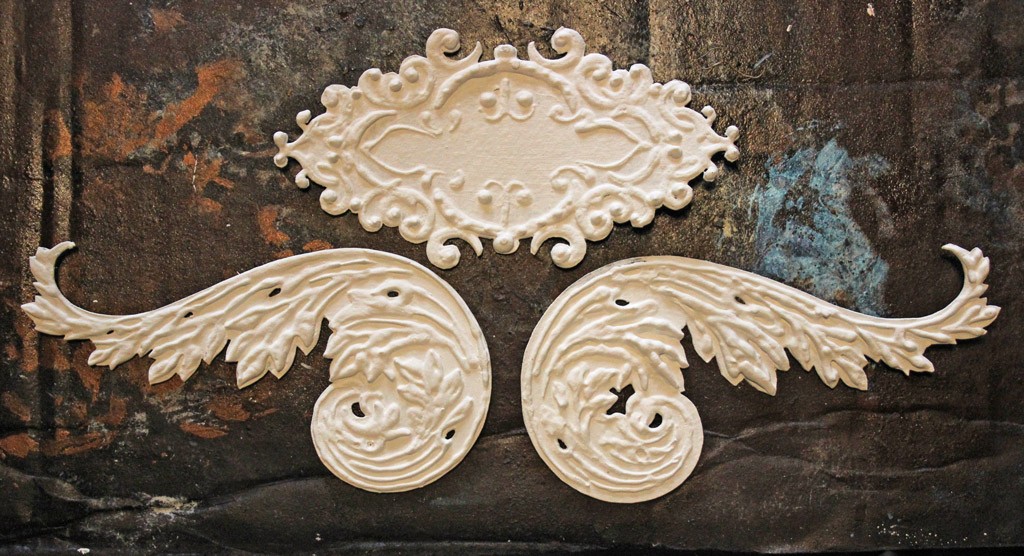
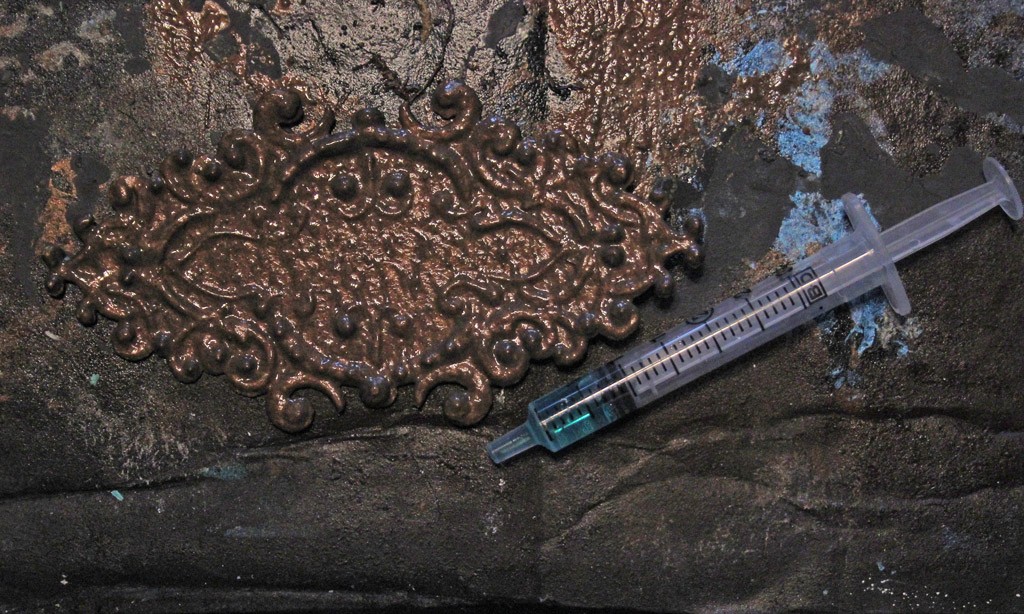
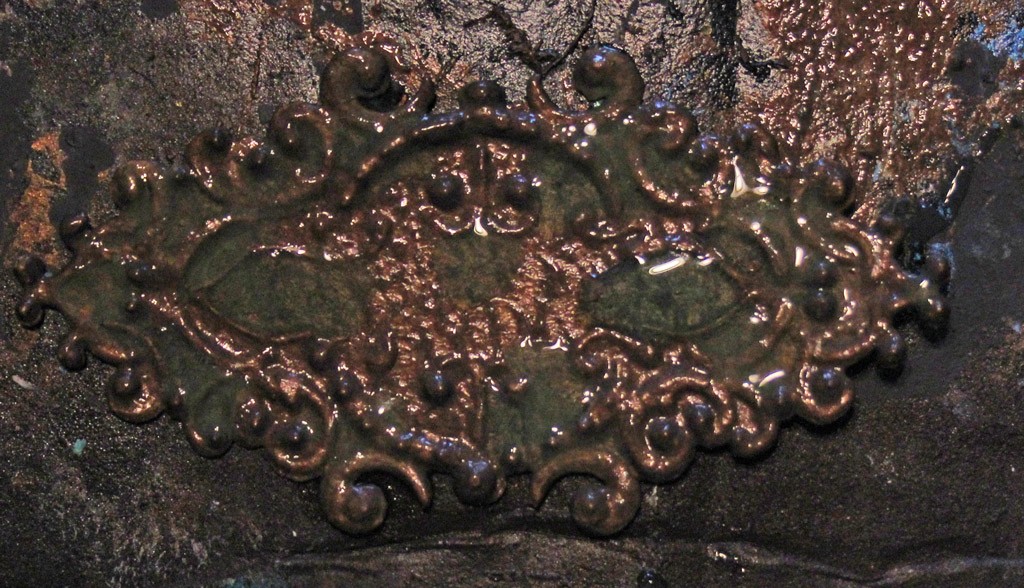
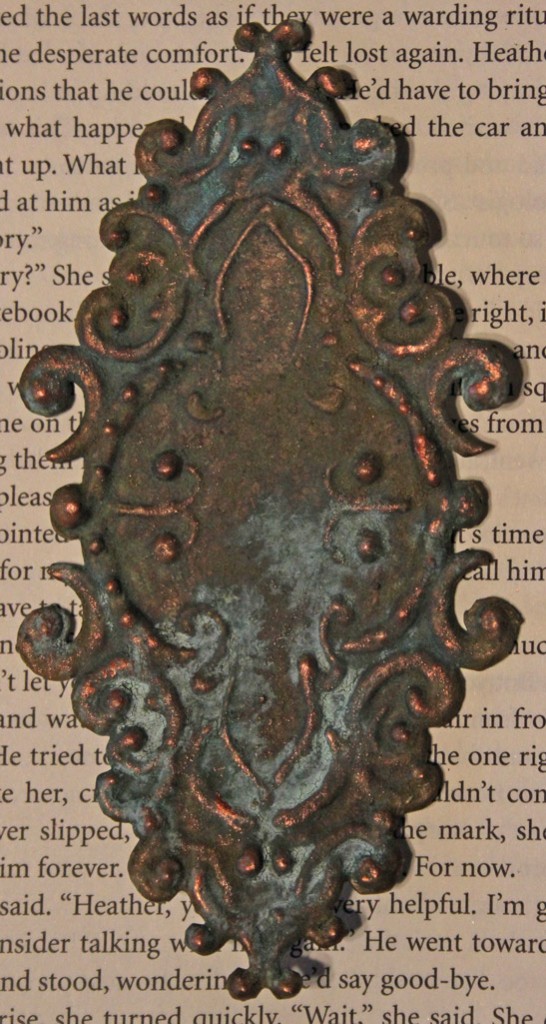
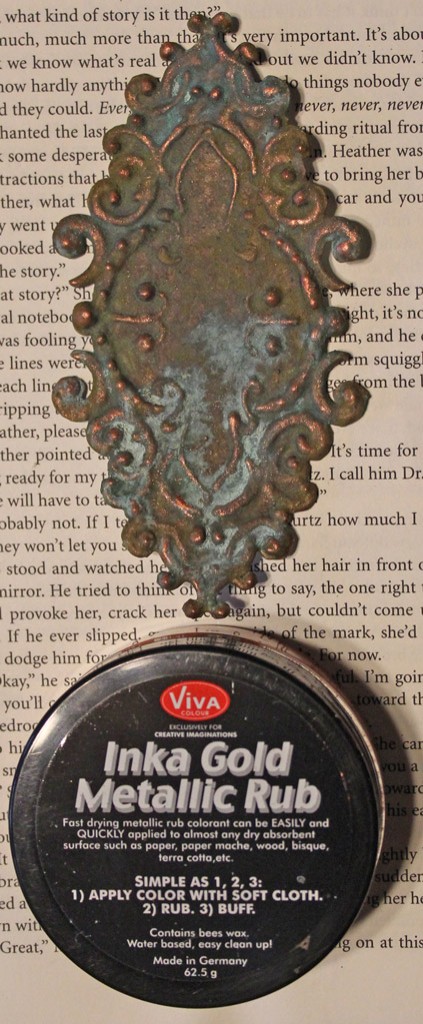
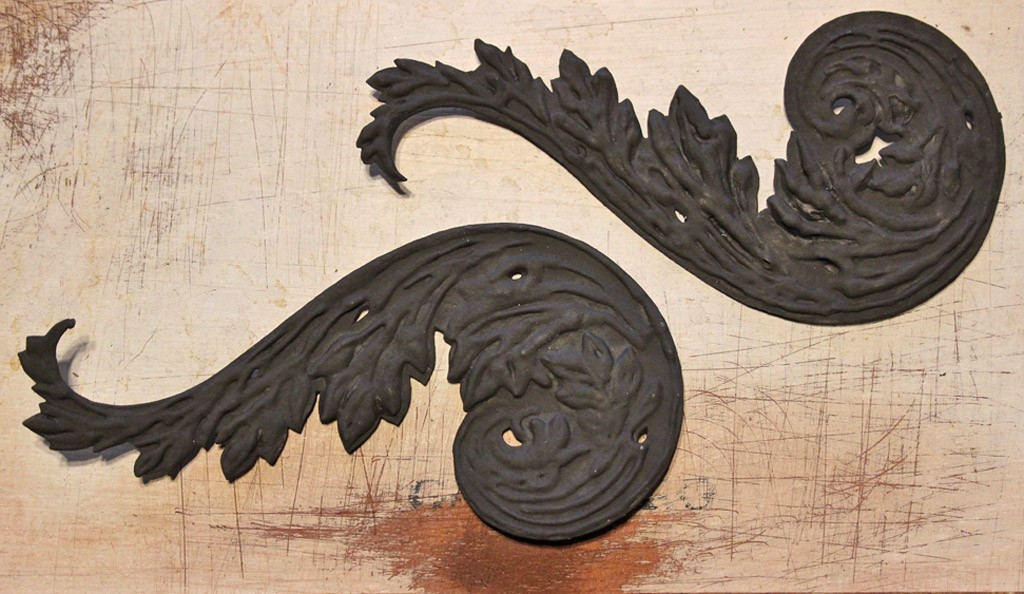
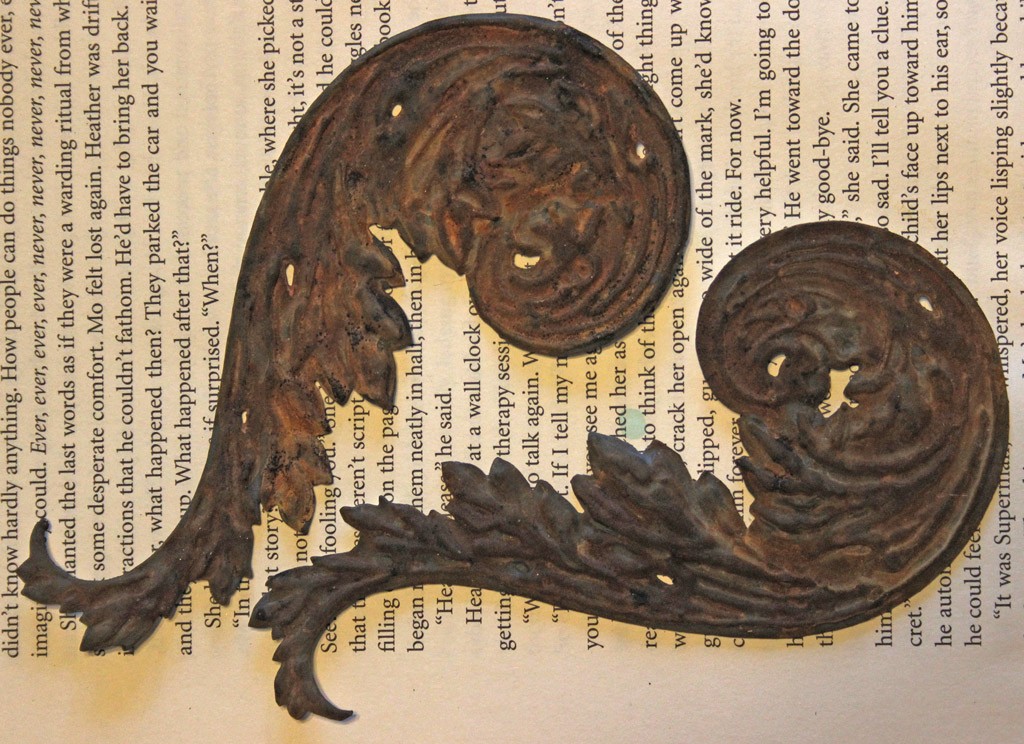
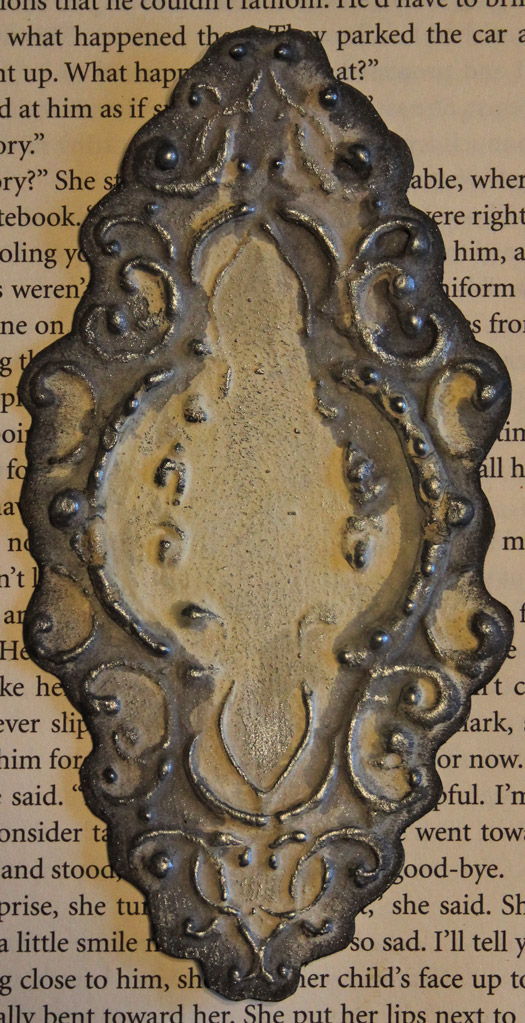
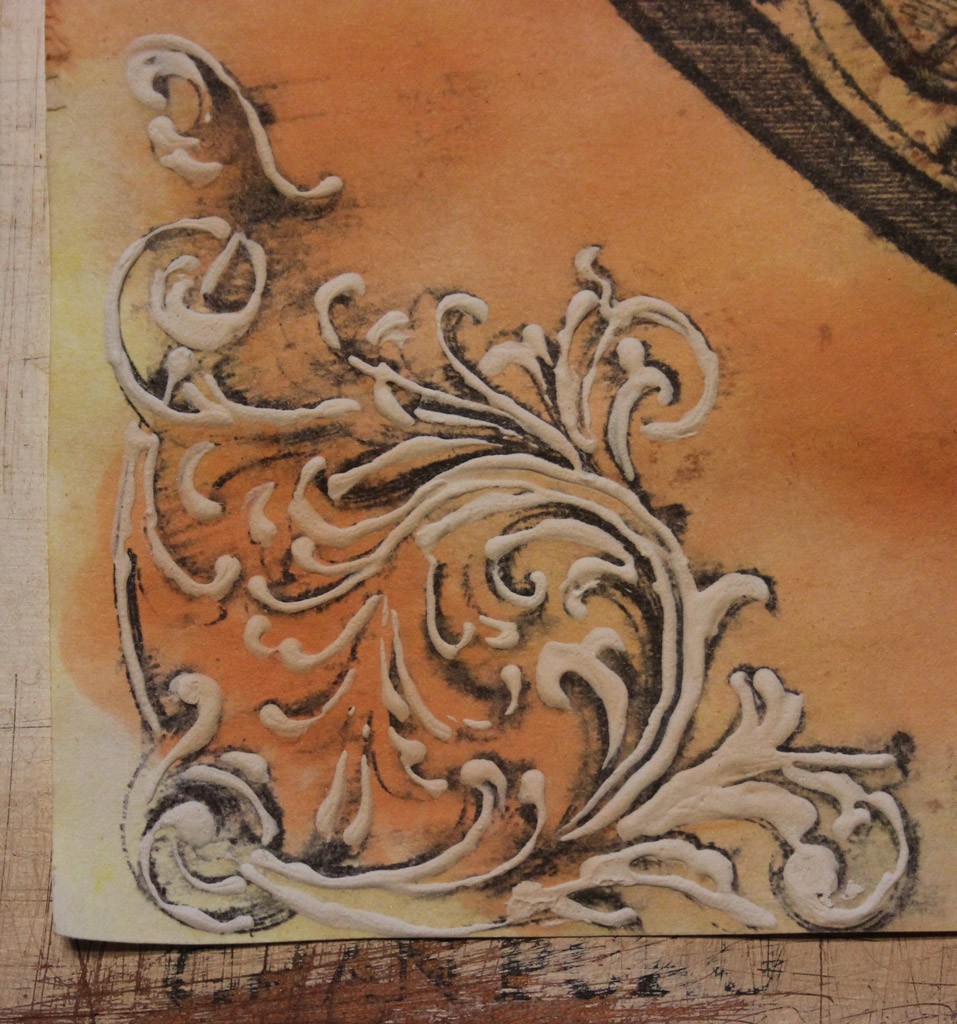
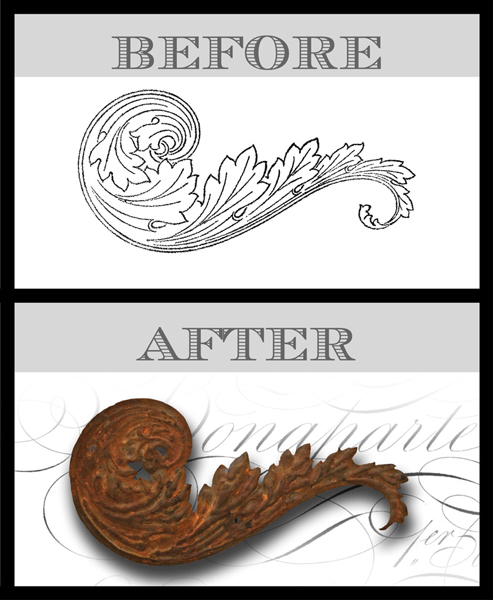
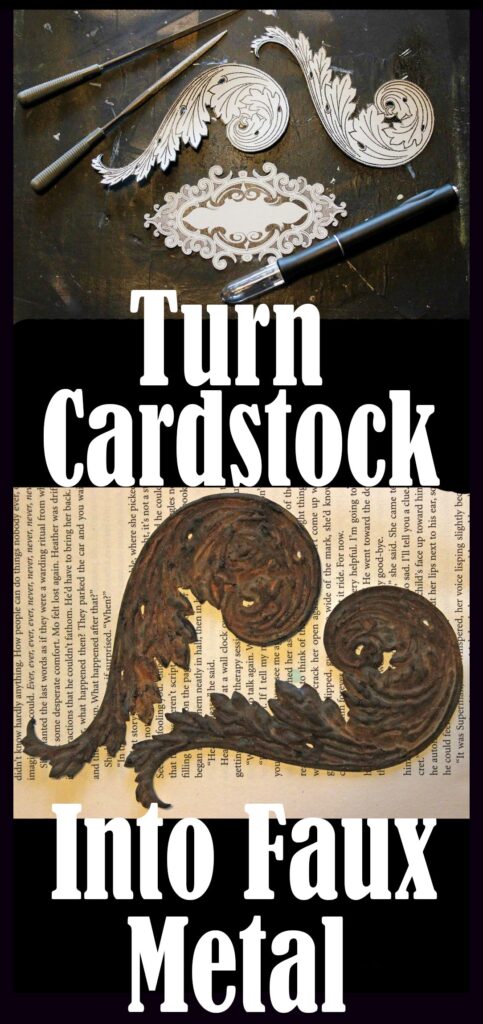
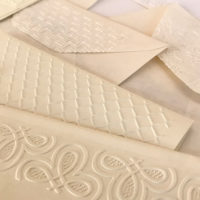
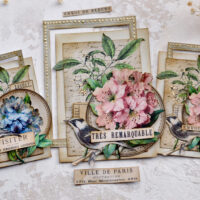
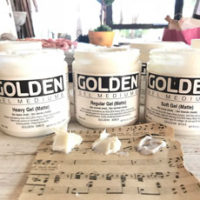




Robbi says
I’m thinking since I have IOD moulds could you use the air dry clay make scroll designs, buttons, keys, corners etc.. with the moulds then do the patina steps. I would think the compound & clay are similar material.
Just another way to use my molds.
Karen Watson says
Great idea Robbi! If you give that a try, let us know how it turns out!
Bonnie says
This is such an awesome idea.. I just love it.. Thanks for the fun tutorial.. My mind is brainstorming like mad:)
Karen Watson says
It’s such a genius technique isn’t it?! Have fun creating these!! 😊
gwen says
Wow how amazing. I love this. I think you’re a great artist, your work is brilliant.
Heather Tracy says
Hi Gwen! And I think YOU are a very generous hearted soul, my friend. Thank you. xox
Karen Wainwright says
Love this idea! I actually have a lot of experience with plaster and faux finish, as a retired Union Scenic Artist, but am always on the prowl for new ideas. OK, I am a couple of years late to this, but that’s retirement for you, right?!
One thing, for those of you who are impatient, ahem, is if you either want to fork over a few bucks, or have a friend in “the trades” (works on houses, doing paint/plaster type work), there are a couple of “setting-compounds” that dry pretty fast. Brand names for novices to try, would be Durabond or Easy Sand. They come in Trades sizes 30 lbs bags, or smaller boxes, and you have a “set”/dry time of either 45 or 25 minutes to choose from.
Unlike Joint Compound/JC, these have much more Plaster of Paris, so they dry MUCH harder. Anything that dries can be knocked off tools with a hammer (if it’s a lot) and then sanded down, but immediate clean-up is KEY!
For those of you who asked about the durability, I will add a little trick that we use in “the biz”, which is you can toss some glue, yes glue, into your JC mix. This, again, will make your clean up more important. JC is extremely water soluble, or sandable, until sealed, as well as relatively soft. White, or other glue, will strengthen it, make it more forgiving if you have it on a costume (ok, not impervious, savvy?!) and in a way, will sort of prime the JC, so your expensive Modern Masters won’t get sucked into it!
You can also try using those hair dye bottles that OTHER people in your family use, or condiment bottles from a $!+ type store, as options for squeezing out fantastic and wonderful creations.
Thank you so much for this fabulous tutorial! Also, I love this site and hey, if you ever want some odd technique I’ve developed to be shared, give me a shout, and I’ll fill you up with a bunch of them to chose from, Dearest Graphics Fairy.
I’m linking to my old and poorly maintained IMDB page, so you see that I do have a few credits to my name, which is the most organised of any art related stuff I do, beyond Social Media, which is under my Nom De Plume….long story!
Karen Wainwright says
Ooops! I almost forgot!
In one Scenic Shop, we used to make these sort of upside down trivets for projects like these. Basically, you get some scraps of wood, maybe one inch thick, by two, or similar, then you drive some drywall, or whatever type of screws you have hanging around, or loose (!) through them, so that the points protrude.
Put four screws through each block of would, close enough for the scale of your project, then flip so that the wood is on the table. The screws balance the work and are fine enough that if some muckity muck dribbles down, it won’t be a major surface to try and separate the piece from after you’re done playing with the dog and it’s dry. Of course, this is only worth your while if you are planning on doing, say, a lot of these for an up-coming holiday gift giving spree, or such. Just saying!
Heather Tracy says
Genius. Yep. Totally brilliant solution for suspending drippy stuff. You rock, Karen! Thank you. I’ll be making several of these to work with. xox
Heather Tracy says
Oh, Karen! How I would love to spend a few days with you…your wealth of knowledge is phenomenal! Thank you SO much for the info on Durabond and Easy Sand…plus, the addition of pva glue is something that I’ve since worked with, and it is fantastic. Condiment bottles? Fantastic. Thank you for enriching the discussion…I feel an updated post coming on! xox
Janie Vantol says
Absolutely mind blowing! Wow! I can’t believe my eyes! This is so craft changing! Thank you thank you thank you for sharing!
graphicsfairy says
Thanks Janie and I love your term “craft changing!”
Susan Arseneault-Ruchard says
Wow, wow, wow! Amazing and beautiful. I am definitely going to try this. Thank you for sharing.
graphicsfairy says
Thanks so much Susan!!
Eclectic Designer says
Dang girl!! This is so amazing! I’m so inspired! I’d have never dreamed cardstock could hold up to such a build, doubled up or not! I’m going to home depot right now to score some joint compound!! But modeling paste would do the same thing…Right? Thank you so much for sharing!
Heather Tracy says
Hey, Eclectic Designer (cool name)… Yep, cardstock and joint compound = super cool dimension for very little money. Yes, modeling paste will definitely create the same effect, but the cost is several magnitudes higher 😉 I just know you’re gonna love working with this technique! Thanks for stopping by, my friend. xox
Kitty Forseth says
I picked up my joint compound and I actually found a cake decorating kit at $ Tree that I am going to try. I like the ornaments just plain white, they are beautiful!! I may make some to sell in my booth but I will definitely use them to embellish my furniture!
Heather Tracy says
Yay! I’m so glad you’ll be giving this technique a try, Kitty…I’m sure it will be wonderful with your furniture! xox
Kitty Forseth says
AMAAAAAZING!!!! Thanks so much for sharing!!
graphicsfairy says
You are so welcome Kitty 🙂
Christal Mac says
This process is amazing! Thank you so much for sharing. I was looking for ways to make a steampunk clock for my husband without actually using metal and this looks like the perfect solution. I was wondering if you have to use DIY chalk paint or if something like milk paint would work?
Heather Tracy says
Hey Christal! Oh, man, your steampunk clock idea sounds AWESOME! My only hesitation with the Milk Paint suggestion is that I understand it is formulated to chip easily – that’s not a quality that you would want for this project. But – ANY paint that creates a permanent ‘skin’ over the texture will be fine. Craft paint, latex paint, gesso. Have fun!
Donna says
how beautiful! What an awesome idea! thank you!
Heather Tracy says
So glad you found it useful – Thank you, Donna!
Heather says
oops forgot to mention using the fine tipped bottle for application you might need to water down the joint compound and glue mixture a bit . End product is still very hard , Then apply your finishes
Heather Tracy says
Thanks for the additional information, Heather – I’m sure it will help to avoid some frustration 🙂
Heather says
Hi again Heather , don’t know if I can send a picture to show what can be done. I redid some old not very valuable octagonl end tables and turned them into night tables . Used this process and some hammered metal paint . Then finished up with painting the 3d wisteria I created on the front panels with the the glue and joint compound with acrylics &spray sealed when dry with a clear laquer. They are 10 years old now and no damage what soever on the raised 3d wisteria
Heather Tracy says
Heather, Wow! Your project sounds AMAZING! I’m sure we would all love to see your 3D Wisteria…you can post pictures at Thicketworks Facebook Page: https://www.facebook.com/thicketworks/ or, feel free to send images to me via [email protected], and I will post them on Facebook to show everyone what you did!